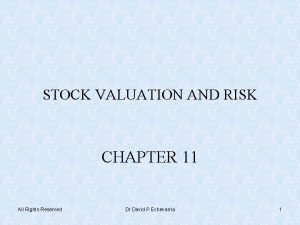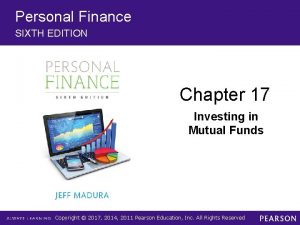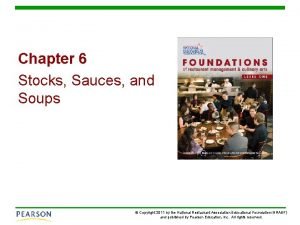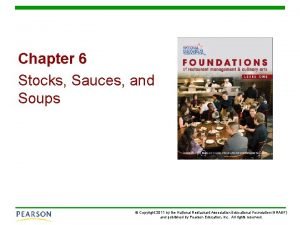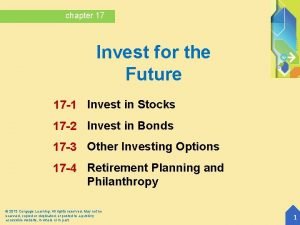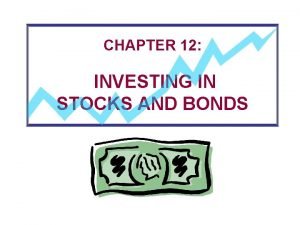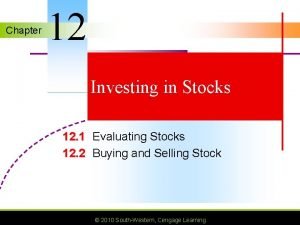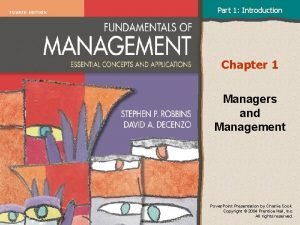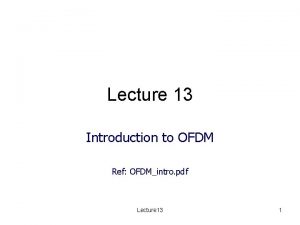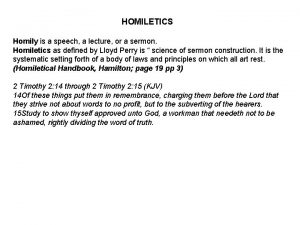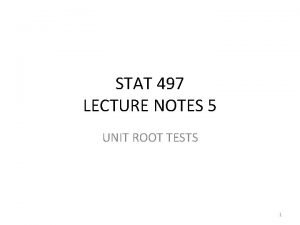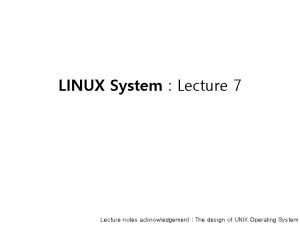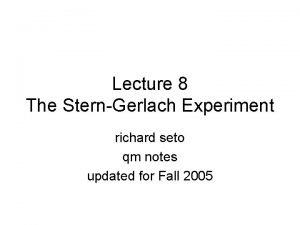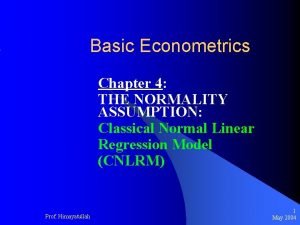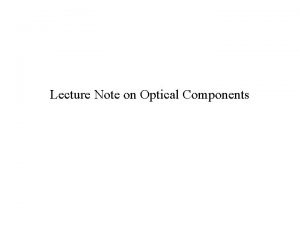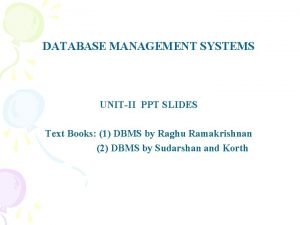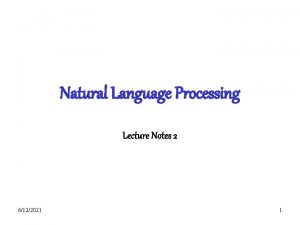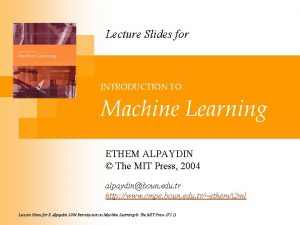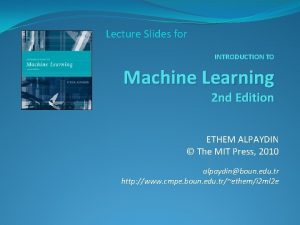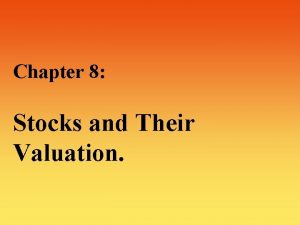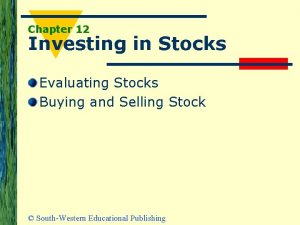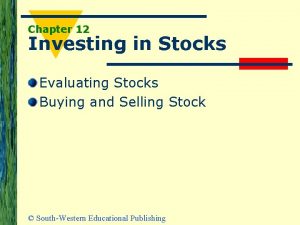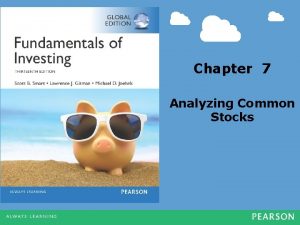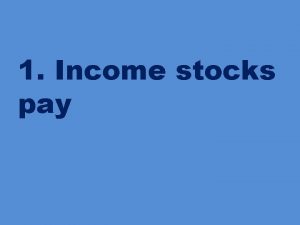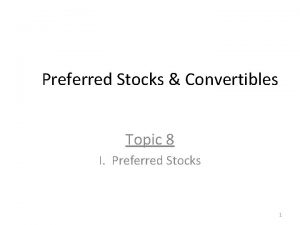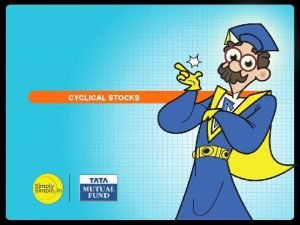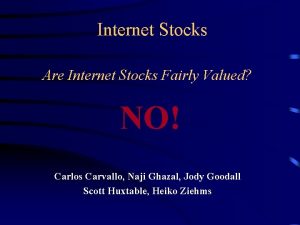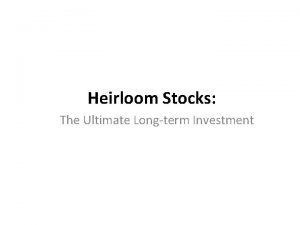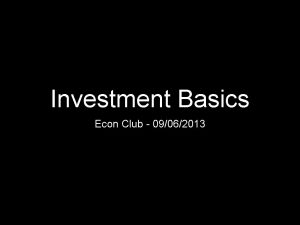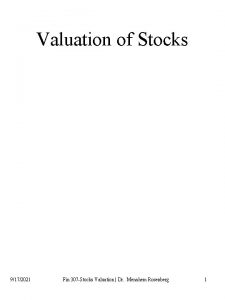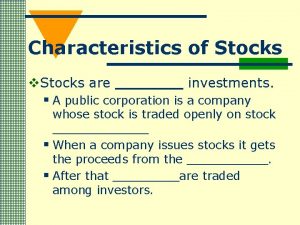CHAPTER 5 Lecture Notes Introduction to Stocks Lecture





























































































- Slides: 93

CHAPTER 5, Lecture Notes Introduction to Stocks (Lecture) The Stock Market (Chapter 5) “Don’t gamble! Take all your savings and buy some good stock and hold it till it goes up. If it don’t go up, don’t buy it. ” -- Will Rogers 1

What Are Stocks? n Where did the term “Common Stocks” come from? The investors are “Shareholders in Common. ” Stocks represent ownership in a corporation w Stocks are Equity Financing – “Equities” w Enable investors to participate in the profits and growth generated by the business enterprise w But stockholders are limited liability owners § Can only lose their investment (unlike a sole proprietor) n Stockholders receive … w Dividends § Optional payments of earnings w Capital Gains – a. k. a. Capital Appreciation § Value of corporation rises as business grows Contrary to what many believe (and how many behave), stocks are not simply millions upon millions of worthless pieces of paper (now electronic bits!) that people trade each day. They represent ownership in real businesses. 2

3 Historical Performance n Over the long-term of modern finance … w The return from the stock market (as measured by the S&P 500) has averaged around 10% to 11% annually for the last eighty years n But in any one year … w It is unlikely that the return will be 10% or 11% w The return has varied from a high of 53. 8% to a low of -43. 4% w 2008’s return was -38. 5%, one of the worst! n And in any given year … w There has been a one-in-three or one-in-four chance of a down market The major exception was the great run-up from 1982 to 2000

4 Historical Performance (continued)

5 Rolling 10 -Year Period Returns 20% 15 10 5 2008 -17 2003 -12 1998– 07 1993– 02 1988– 97 1983– 92 1978– 87 1973– 82 1968– 77 1963– 72 1958– 67 1953– 62 1948– 57 1943– 52 1938– 47 1933– 42 Rolling 10 -Year Periods 1928– 37 0 Source: The unmanaged Dow Jones Industrial Average, based on average annual compound returns over 10 -year periods.

6 Historical Performance n (continued) Traditionally, close to half of the return from stocks was from reinvested dividends w Stockholders used to expect 4% to 6% in dividends each year – That was as much or more than bonds returned in interest since stocks were considered much riskier than bonds § The S&P 500 dividend average from 1936 to 2008 is 3. 8% n But dividends fell to less than 2% & even 0%! w Capital gains & growth were what people wanted in the 1990’s § The S&P 500 dividend averaged 1. 5% from 1997 to 2007 n Reasons given are varied w Dividends were taxed at a higher rate than capital gains w People wanted the business to reinvest the earnings for growth instead of distributing it to the investors w Stocks were no longer considered riskier than bonds w Savings accounts were also paying less than 2% w People lost track of their senses and bid up the prices

7 Historical Performance (continued)

8 Historical Performance (continued) n The Pendulum Swings… w The Bear Markets of 2000 -2002 and 2008 have changed investors’ perception about dividends w We now see investors and companies focusing more and more attention on dividends w Many companies that never paid dividends in the past are doing so now § Example: Many tech companies are no longer growth stocks. They are mature industries w Also, the tax law has changed dividends so that they are taxed roughly the same as capital gains “Dividends Don’t Lie. ” − Geraldine Weiss “Do you know the only thing that gives me pleasure? It’s to see my dividends coming in. ” − attributed to John D. Rockefeller

9 Pros & Cons of Stock Ownership n Pros w Allow general public to share in the rewards of business enterprise w Best financial investment returns over time § Dividends and capital gains w Easy to buy & sell – liquid investment w Limited liability w Increased standard of living for all n Cons w Risky w “Volatile” (industry’s popular euphemism for losing money) w Corporate and financial industry hanky-panky!

“Volatility” Examined 10

11 Primary versus Secondary Market n Primary Market w The market in which new issues of securities are sold to the public w Initial Public Offering (IPO) § The first public sale of a company’s stock § a. k. a. “Going public”, “Taking the company public” w Most retail investors do not participate in the primary market § (And my recommendation is that we really shouldn’t) n Secondary Market w The market in which securities are traded after they have been issued to the public w The vast majority of transactions take place in the secondary market

12 Primary Market n Why “Go Public? ” w Why do corporations issue common stock? § To raise money to start or expand a business § To help pay for ongoing business expenses § As a way to gain prestige and respect within the investment and industrial communities § As a reward for those who started the business § And also simply because once a business becomes sufficiently large, it becomes very difficult for the owners to “divvy up the spoils” without going public § If you were one of the people who started GE or Coca-Cola or Walmart, how would you sell your share of the business? What are some of the largest private companies?

13 Primary Market n (continued) Why “Go Public? ” (continued) w The corporation does not have to repay the money w It is under no obligation to repurchase the shares of the stock § The shareholder may or may not be able to find someone who will purchase the shares from them w But the corporation is now a public entity § As such, it now has many rights and responsibilities that private companies do not need to worry about § Must file 10 K’s & 10 Q’s with the SEC § Must have at least one public meeting annually Chapter 5 goes into much detail about IPOs do not usually live up to their expectations. The typical IPO loses 50% of its value in one year.

14 Secondary Markets n Markets in which securities are sold after they have been issued w a. k. a. Aftermarket n Secondary markets provide… w Liquidity § Easy method for transferring ownership of securities w Mechanism for pricing and valuation of securities When people talk about the “stock market, ” they are almost always referring to the secondary market.

15 Types of Secondary Markets n Organized Securities Exchanges w Centralized institutions in which transactions are made in outstanding securities w “Double Auction” Market (Face-to-Face) n Over-the-counter (OTC) Market w Widely scattered telecommunications network through which transactions are made in outstanding securities and smaller IPOs w Quote-based system (On-line) This is an outdated comparison. Due to technology advancements, mergers, and acquisitions, the traditional differences between the two have been erased. And the changes are just gettin’ started!

16 Organized Securities Exchanges n Historically… w All trading was conducted on an exchange floor w Trading was conducted using a “double auction” § Instead of the “one seller, multiple buyers” that you see at an estate or farm auction, for example, § There were “multiple sellers and multiple buyers” § Brokers on the floor call out prices & quantities w But due to both technology & the sheer massive volume of shares traded, things have changed § Almost all of the trading is now conducted electronically w Some large trades still involve human interaction § But they now consist of far less than 1% of the total number of trades

17 The New York Stock Exchange n n a. k. a. NYSE, the “Big Board” Traditionally, responsible for over 90% of the volume of transactions on exchanges – 1, 900 companies w About $20 trillion of market capitalization (Jun 2016) n Established as a members-only entity in 1792 w When Wall Street really was next to a wall n Companies listed on the NYSE must meet stringent requirements w The largest and most prestigious (traditionally) n Companies can be de-listed (example: Kodak) w If they fail to continue to meet the NYSE requirements

18 The New York Stock Exchange (continued) n Big Changes at the NYSE w In 2005, purchased Archipelago electronic exchange and the Pacific regional exchange w Became a publicly traded corporation in March of 2006 § When they merged with the Euronext electronic exchange w Phased out face-to-face, double auction trading § In favor of exclusively trading electronically w In 2011, Germany’s stock market tried to purchase the NYSE but was blocked by European regulators w On November 13, 2013, the NYSE was acquired for $11 billion by a 13 -year-old derivatives trading firm from Atlanta, Intercontinental Exchange In 1992, on their 200 th birthday, if you had told the folks at the NYSE that the next 20 years would see far more changes than in their first 200 years, they would have thought that you were quite insane. Press Release from ICE announcing completion of acquisition of NYSE "The End of the Street" -- The Economist, 16 November 2013

19 The New York Stock Exchange (continued) n The Floor Brokers w House Brokers § Execute orders on behalf of their firm’s customers or occasionally on behalf of their firm’s own account w Independent Brokers § Provide as-needed execution services to house brokers, member or non-member broker-dealers § Independent of a particular firm § a. k. a. “$2 Brokers” The floor brokers were very worried that the NYSE’s aggressive moves to all-electronic trading meant the end of their way of life. It was not really the end; it was just a big change – from face-to-face interaction to sitting in front of a computer screen all day. Sound familiar?

20 The New York Stock Exchange (continued) n The Specialists w Stock exchange members who specialized in making transactions in one or more stocks w The job of the specialist was to manage the auction process. The specialist buys or sells the stock from their own inventory to provide a continuous, fair, and orderly market w The role of the specialists has essentially been squeezed out by technology and the tremendous volume of trading They are involved in only a tiny amount of trading each day w The specialists were replaced by “designated market makers” and “supplementary liquidity providers” in 2009 From time to time, the specialists were either praised or maligned. Suffice to say that the specialists were trying to make a profit just like everyone else. While their goal may have seemed altruistic, they made sure that when the market received benefits from their efforts, so did they. http: //www. investopedia. com/university/electronictrading/trading 2. asp

21 The American Stock Exchange n The American Stock Exchange w a. k. a. the AMEX, the “Curb” (? ) – Now the NYSE MKT! § Where did that name come from? They started on the curb outside the NYSE! (Image: AMEX Curb Brokers) w Much smaller than the NYSE § Only 3% of the volume of all exchanges w The AMEX started concentrating on securities other than stocks over 20 years ago w Purchased by the NASDAQ in 1998 w Went independent again in 2004 w Acquired by the NYSE in 2008 § They then moved down the street to the same building as the NYSE and their name was changed to NYSE MKT The ETFs were first introduced on the AMEX.

22 The Regional Stock Exchanges The regional stock exchanges were modeled after the NYSE and AMEX n Only account for 4% of exchange volume n w w w Many of the securities listed on the regional Chicago Philadelphia exchanges are also available on the NYSE or NASDAQ. Traditionally, the regional Pacific exchanges were often places where Boston undesirable or unethical issues were sold. Lately, the regional exchanges have tried to Denver diversify and differentiate themselves from Cincinnati the NYSE and NASDAQ in order to survive. Plus the regional exchanges have not been immune to the rush to consolidate. The NYSE bought the Pacific Exchange and the NASDAQ bought the Philadelphia Exchange.

23 Options and Futures Exchanges n Options allow traders to sell or to buy an underlying security at a specified price for a given time w The Chicago Board Options Exchange (CBOE) n Futures are contracts that guarantee the delivery of a specified commodity at a specific future date at an agreed-on price w Chicago Board of Trade (CBT) We will discuss options and futures in detail later. Options and futures are also traded on most all the major and regional exchanges now as well as the two major exchanges noted above.

24 The Over-the-Counter Market n Widely scattered telecommunications network through which transactions of securities are made – a. k. a. OTC w There is no single location as with an exchange n Quote-based system w As opposed to the double auction of the exchanges n Three tiers w NASDAQ – National Association of Securities Dealers Automated Quotation system § The NASDAQ does not want to be associated with the OTC anymore The Nether Worlds § OTC Bulletin Board – 5, 000 securities Stay Away! w OTC Markets Group § nee Pink Sheets – 20, 000+ thinly traded securities § It appears that they are trying to clean up their act: OTC Markets

25 The Role of Dealers in the OTC n Dealers are traders who “make markets” by offering to buy or sell certain securities at stated prices – a. k. a. “market makers” w The dealers offer buy and sell quotes from their own inventory of stocks § Whereas brokers simply serve as a go-between buyers & sellers. They keep no inventory w Ask price – “retail price” § The price a dealer offers to sell a security w Bid price – “wholesale price” § The price a dealer offers to purchase a security w The spread § The difference between the bid and the ask prices The dealers / market makers on the NASDAQ perform roughly the same role as the specialists on the NYSE. http: //www. investopedia. com/university/electronictrading/trading 3. asp

26 The Role of Dealers in the OTC (continued) n Unlike brokers who charge a commission dealers make money from the spread of the bid and ask prices w Just as the Casas de Cambio in San Ysidro make money on the difference between the prices in which they buy and sell pesos and dollars n The dealer’s markups or markdowns are not reported to the customers w Whereas the broker’s commissions are reported How do you think the Internet brokers make money on only $5 or $7 per trade? (More later)

27 The NASD and the NASDAQ n National Association of Securities Dealers Automated Quotation system – NASDAQ w National Association of Securities Dealers (NASD) § Non-governmental organization that used to be responsible for self-regulation of registered representatives (stockbrokers) – (Now done by FINRA) § The NASD is now simply called the NASDAQ w Created the first electronic communications network for trading securities in 1971 w Provides up-to-date bid and ask prices on approximately 2, 800 stocks The NASDAQ used to be the arena for small companies to get started. Once they became large enough, they would move to the NYSE. However, since the 1980’s, many prestigious companies decided to stay on the NASDAQ rather than move to the NYSE.

28 The NASD and the NASDAQ (continued) n The NASDAQ is now a three-tier system w NASDAQ Global Select Market § 1, 550 “crème de la crème” § Companies that would easily qualify for the NYSE w NASDAQ Global Market § nee NASDAQ National Market § 760 larger companies w NASDAQ Capital Market § nee NASDAQ Small. Cap Market § 790 smaller companies The NASDAQ began positioning itself as the “Securities Market of the Future” as it became apparent that the traditional face-to-face, double auction model was not adequate to keep up with the massive increase of trading. The NASDAQ market capitalization is roughly $12 trillion. Listing of Nasdaq Companies

29 Alternative Trading Systems n Third market w Over-the-counter transactions made in securities listed on the NYSE, AMEX, or one of the other organized exchanges w Institutional investors who trade in large blocks of securities get to use third market § Mutual funds, insurance companies, pension plans, etc. w Reduced transaction costs § But still facilitated by a dealer w Example: Intermarket (became the NASDAQ Intermarket)

30 Alternative Trading Systems (continued) n Fourth market w Traditionally, transactions made directly between large institutional buyers and sellers of securities w Allowed the institutions to bypass the dealers § Get rid of the middleman w Electronic Communications Networks (ECNs) § Privately owned electronic trading networks that automatically match buy and sell orders that customers place electronically w Examples: Archipelago (became the NYSE Arca), BATS With the advent of the Internet, the third and fourth markets successfully started to court retail customers. This got the attention of the NYSE and the NASDAQ!

“But Isn’t the Stock Market All Just One Big Malignant Casino? ” n “Yes” 31 The Answer is “Yes” and “No” w There are many individuals who see the markets as one big crap-shoot w For them, the way to riches is to buy and sell, buy It is very difficult and you are up and sell, buy and sell against the best in the business. w We call them speculators Neophytes become very upset when n “No” a. k. a. traders the market turns against them. w Many others look at the capital markets as a way to participate in the growth & prosperity of the global With a long-term orientation, investors economy are usually very well rewarded. w We call them investors “An investment operation is one which, upon thorough analysis promises safety of principal and an adequate return. Operations not meeting these requirements are speculative. ” − The Intelligent Investor, Benjamin Graham

“Oh, Yeah, But What About Enron? Aren’t Corporations All Crooks? ” n 32 Fraud and accounting trickery and gimmicks have always been with us w They are always going to be with us w “Because that is where the money is!” w Normally, but not always, those firms are relegated to the nether reaches of the OTC w But for every one Enron, there are hundreds – no, thousands! – of companies that continue to do business with integrity and honesty (uh, usually… ) In 1973, it was Equity Funding. In 1986, it was Ivan Boesky and Vagabond Inns. In 2002, it was Enron, Global Crossing, Tyco, and World. Com. In 2008, it was Fannie, Freddie, Lehman, Citi, Wa. Mu, Wachovia, and AIG. And don’t forget Madoff! Ten or twenty years from now, during the next big bull market craze, someone else will take their place.

Recap: Securities Markets n The securities markets exist to allow investors a safe, cost-effective method to participate in the success of the global economy w And even with all the underhanded shenanigans, they have performed very well n 33 They are changing at breakneck speed w And the change is accelerating Whether or not we ever have one or more global, 24 -hour trading markets remains to be seen. But it is exciting (and, for some, scary) to watch, especially for those of us who have a stake in the outcome.

34 Bull Markets vs Bear Markets n Bull Market w Favorable markets normally associated with rising prices, investor optimism, economic recovery, and government stimulus n Bear Market w Unfavorable market normally associated with falling prices, investor pessimism, economic slowdown, and government restraint Where did the terms bull market and bear market come from? Bear Skin Jobbers: “Don’t sell the bear skin before the bear is caught. ”

35 Types of Stock Transactions n Market Order w “Buy/sell at the current price” n Limit Order w “Buy/sell only at the price you specify” n Stop-loss Order (a. k. a. Stop Order) w “Buy/sell at the current price once a trigger point is reached” n Stop-limit Order w “Buy/sell only at the price you specify once a trigger point is reached” Although you can use limit orders to buy or sell at the price you want, and stop-loss and stop-limit orders to “lock-in” profits or protect against losses, remember that they trigger automatically. If for some reason, you change your mind, it is often too late to cancel the order.

36 Types of Stock Transactions (continued) I normally use and recommend market orders. Short-term traders tell me they prefer limit orders or stop orders on all their trades.

37 Types of Stock Transactions (continued) n Buying on Margin w Borrowing money from your broker to enhance your return w You can borrow up to 50% of the purchase price of a stock n Selling Short w Borrowing stock and selling it in the hopes that the price will go down (Sell stock you do not own! Huh? ) w You must buy it back at some time in the future The book spends much time discussing margin accounts and selling short in chapter 2. We will discuss these in detail late in the semester. My advice to you is never sell short. It is simply too risky. Using a margin account can be useful once you have built a substantial portfolio. It allows you to borrow from your portfolio without selling your stocks.

38 Transaction Costs n Traditionally, transaction costs were in the 1% to 5% range, sometimes higher w The largest portion was the brokerage commission n Deep-discount Internet brokers have driven the commissions down to as low as $5 per trade w A few firms used to offer free trades but stopped w A company called Robinhood is now currently offering free trades, targeted to young adults n But have transaction costs really gone down? w Yes, but more and more of the cost is hidden from the investor Especially the “Internet garbage” brokers. (Those aren’t my words!)

39 Transaction Costs n (continued) Example: w A deep-discount Internet broker offers trades for $7 w In the fine print of the client-broker agreement is included a provision for allowing the broker to solely utilize exclusive stock dealers and market makers § The quoted price is simply the best price available but at any one time, there are dozens of prices quoted as dealers and market-makers compete for buy and sell orders w The chosen dealer doesn’t necessarily have the best price § Instead of paying $20, the investor might pay $20. 05 The investor sees the $7 commission on their confirmation. The investor does not see the extra $5 they paid on a 100 share purchase because of the dealer’s markup.

40 Transaction Costs n (continued) The following disclaimer is included in each trade confirmation e-mail from Scottrade SCOTTRADE INC. RECEIVES REMUNERATION FOR DIRECTING ORDERS TO PARTICULAR BROKER/DEALERS OR MARKET CENTERS FOR EXECUTION. SUCH REMUNERATION IS CONSIDERED COMPENSATION TO THE FIRM AND THE SOURCE AND AMOUNT OF ANY COMPENSATION RECEIVED BY THE FIRM IN CONNECTION WITH YOUR TRANSACTION WILL BE DISCLOSED UPON REQUEST In Scottrade’s defense, at least they prominently disclose this relationship. Many others hide it in their customer agreement fine print and the customers are never aware of the relationship.

41 Transaction Costs n (continued) The SEC says that “your broker has a duty to seek the best execution that is reasonably available for its customers' orders” w But it is not a guarantee w “… the SEC requires broker/dealers to notify their customers if their orders are not routed for best execution. Typically, this disclosure is on the trade confirmation slip you receive … after placing your order” – Investopedia http: //investopedia. com/articles/01/022801. asp w And determining whether or not a customer got “best execution” can be very difficult Here is an example of the SEC trying to enforce the rules: http: //lawprofessors. typepad. com/securities/2008/06/scottrade-settl. html

42 Transaction Costs n (continued) The SEC was looking into making the costs more transparent w Possibly showing the customer the difference between the dealer’s price and the best price available at the time of the transaction § Maybe even – gasp! – showing the total cost of the transaction from the markup/markdown w Needless to say, the deep-discount brokers cried that it would drive up the cost of commissions and ultimately hurt the consumer and the proposal died w So it is up to you to check if you are getting the “best execution” But how can you, a lone investor, determine if you are getting the best price if even the SEC has trouble watching over the brokerage companies?

43 Transaction Costs n (continued) High Frequency Trading (a. k. a. HFT) w Uses computers to transact large numbers of orders at very fast speeds § Detailed in the book Flash Boys by Michael Lewis w There is little doubt that High Frequency Trading has reduced transaction costs § However, at the same time, HFT firms have been accused of using their ability to transact at the microsecond level to “front run” investors § Essentially stealing tiny amounts of money from the average retail investor and even large players like mutual funds w One firm, IEX, is fighting back and has the backing of some very large market players IEX has created what they call a “speed bump” so the HFT firms can not “jump” in front of you and “front run” your transaction. In June 2016, the SEC approved IEX’s bid to become an exchange. Stay tuned! http: //www. latimes. com/business/la-fi-capital-group-iex-20160815 -snap-story. html

44 Round Lot versus Odd Lot n Round Lot w 100 shares or multiples of 100 shares n Odd Lot w Less than 100 shares n Mixed Lot w Lots over 100 shares but not evenly divisible by 100 n Odd-lot Differential w Extra cost of trading an odd lot w Traditionally, the odd-lot differential was 12½¢ - 25¢ w It is now typically less than 5¢ Some people recommend against odd-lot purchases because of the higher cost. On 10 shares, an odd-lot differential might be $1. On 80 shares, it might be $2. Big deal.

45 Reading Stock Quotes Current price during trading hours n The bid and the ask n Open, High, Low, Close (a. k. a. Last) n 52 -Week High and Low sources will contain some, all or n Dividend Yield more. Different of these statistics. But always remember that the quoted prices are not the only prices n P/E Ratio available. At any one time, there are many prices available from many different n Volume dealers/market-makers. The quoted prices are the best prices available. Plus, usually you are n Net Change seeing the current prices 15 to 20 minutes ago. n Year-to-Date Change n

46 Reading Stock Quotes (continued) Wall Street Journal Example “Omigod! You mean you actually wait until the next day to find out how much your stock is worth? ! How Twentieth Century!”

47 Reading Stock Quotes n (continued) On-line Examples w bloomberg. com w marketwatch. com (free version of Wall Street Journal) w morningstar. com w www. google. com/finance w Any others you want to check out? Yahoo Finance used to be the best free finance web site on the Internet, period. Sadly, Yahoo has literally destroyed the Finance page along with the rest of the Yahoo web site. (Note to online students: Please see the accompanying presentations on how to use the above web sites to do your stock research. )

48 Market Averages and Indexes n How can we say that “stocks have returned approximately 10% over the past 70 years? ” w The industry uses market averages and indexes § “Benchmarks” used to measure the general behavior of securities prices by reflecting either the average price behavior (market average) or relational price behavior (market index) of representative groups of securities at a given point in time w You can not help but hear about these every day in the news § “The Dow went down! The NASDAQ went up!” The differences between a market average and market index are subtle. Most people do not even know there are differences.

49 Market Averages and Indexes (continued) n Share price calculation (Market Average) w Looks solely at the price of the stock without regard to the market value § Example: Dow Jones Industry Average n Market-weighted calculation (Market Index) w Stock price times number of shares outstanding w Takes into account the market value of the stock in the index w The larger the market share, the more influence the security will have in the index § Example: Standard & Poor’s 500 Stock Index Market-weighted calculations were generally regarded as a better measure until the bubble of the late 1990’s.

50 The Dow Jones Industrial Average n Stock market average made up of 30 high- quality stocks selected for total market value and broad public ownership and believed to reflect overall market activity w w Share price calculation Most famous of the stock market measures a. k. a. the Dow, the Dow Average, the DJIA Changes from time to time as companies and industries evolve § As such, it now has more non-industrial stocks than industrial stocks Dow Jones is the company that publishes the Wall Street Journal. In 2007, it was purchased by Rupert Murdoch of Fox News fame. It appears that they sold the DJIA and all their other indices to S&P.

51 The Dow Jones Industrial Average (continued) The Thirty Stocks in the Dow Jones Industrial Average American Express Goldman Sachs Pfizer Apple Home Depot Proctor & Gamble Boeing IBM 3 M Caterpillar Intel Travelers Chevron Johnson & Johnson United Healthcare Cisco Systems J. P. Morgan Chase United Technologies Coca Cola Mc. Donald’s Verizon Disney Merck Visa Dupont Microsoft Walgreens Boots Exxon. Mobil Nike Walmart

52 Other Dow Jones Averages n Dow Jones Transportation Average w 20 railroad, airline, freight, etc. n Dow Jones Utilities Average w 15 public utilities n Dow Jones 65 Stocks Composite Average w Industrial, Transportation & Utilities stocks n Dow Jones U. S. Total Stock Market Index w nee Dow Jones Wilshire 5000 Total Market Index w nee Wilshire 5000 n Dow Jones U. S. Completion Total Stock Market Index w nee Dow Jones Wilshire 4500, nee Wilshire 4500 w It is the Wilshire 5000 minus the 500 stocks in the S&P 500 n Dow Jones Internet Index

Standard & Poor’s 500 Composite Index – a. k. a. the S&P 500, the S&P n 53 500 stocks chosen for market size, liquidity, and industry group representation w Market-value weighted index w Traditionally, the largest 500 companies based in the United States (can now contain foreign stocks) w Very popular index although has lost some of its original focus w Used by many index mutual funds Because the S&P 500 is market-weighted, it was affected by the tech bubble of the late 1990’s in a bizarre manner. The market values of a small percentage of technology companies were inflated to extremes. This skewed the index even more toward those companies. Consequently, in 1998, 10% of the gain in the S&P 500 was due to one stock.

54 Other Standard & Poor’s Indices n Standard & Poor’s Industrial 400 n Standard & Poor’s Midcap 400 w Medium-sized companies n Standard & Poor’s Smallcap 600 w Small companies n Standard & Poor’s 1500 Index w Includes 500 Index, Midcap 400 and Smallcap 600 n Other Standard & Poor’s Indices w Transportation, Utilities, Financials w Many other global, international & sector indices

55 NYSE, AMEX and NASDAQ Indices n NYSE Composite Index w Measure of the current price behavior of approximately 2, 000 stocks listed on the NYSE n AMEX Composite Index w Now called the NYSE MKT Composite Index n NASDAQ Composite Index (a. k. a. tech index) w Ditto for the NASDAQ n NASDAQ 100 Index w Top 100 non-financial firms listed on the NASDAQ The NASDAQ Composite went from 800 in 1995 to 5000 in 2000 and then dropped to 1200 in 2002 before starting to recover in 2003. The NASDAQ indices are technology laden.

56 Other Popular Stock Market Indices n Total Stock Market Indices w Dow Jones U. S. Total Stock Market Index § nee Dow Jones Wilshire 5000 Index § nee Wilshire 5000 w Now competing with S&P Total Market Index and § MSCI US Broad Market Index n Extended / Completion Stock Market Indices w Dow Jones U. S. Completion Total Stock Market Index § nee Dow Jones Wilshire 4500 § nee Wilshire 4500 w Now competing with the S&P Completion Index

57 Other Popular Stock Market Indices (continued) n Russell 2000 w Meant to measure small company performance in the United States § Russell 1000 is the top 1, 000 largest companies § Russell 3000 is the top 3, 000 companies § Russell 2000 is the top 3, 000 without the top 1, 000 n MSCI Indices w Morgan Stanley Capital International w MSCI World Index (Global developed world) § The MSCI All Country World Index is replacing the World Index § Includes developing world countries w MSCI EAFE Index (International developed world) § The MSCI All Country World ex-USA Index is replacing the EAFE Index – (again, includes developing countries) Stock Worksheet #1 contains the indices you should know by name

58

59 stock market index ennui

60 “Volatility” Re-examined You will not see this graph on the nightly news!

61 Common Stock Characteristics n Stock Spin-off w Conversion of one of a firm’s subsidiaries to a stand -alone company by distribution of stock in that new company to existing shareholders w Sometimes, the new company is still majorityowned by the company that spun it off § Kraft was spun off from Altria (Philip Morris). Altria then divested itself of its international tobacco business (now called Philip Morris International) The history of spin-offs has been checkered. Some spin-offs have done better than the companies that spun them off. Examples of this are the Baby Bells after being spun off from the old AT&T. Some spin-offs have not fared so well. Coca-Cola Enterprises (spun off from Coca-Cola) and Lucent Technologies (spun off from the old AT&T) are examples of disappointments.

62 Common Stock Characteristics (continued) n Stock Split w A maneuver in which a company increases the number of shares outstanding by exchanging a specified number of new shares of stock for each outstanding share § Example: 2 for 1 split – You had 100 shares; you now have 200 shares § “Big Deal!” – the price went from $20 down to $10 w There are 3 for 1 splits, 3 for 2 splits, 1 for 5 splits… There is no increased value from stock splits. If you had 1 share at $20, now you have 2 shares at $10; the value is still $20. It is a psychological increase at best. Warren Buffett of Berkshire Hathaway has refused to split his stock since its inception. A single share now goes for around $300, 000!

63 Common Stock Characteristics (continued) n Treasury Stock w Shares of stock that have been sold and subsequently repurchased by the issuing firm § a. k. a. Share Buybacks, Buybacks w Share buybacks reduce the number of outstanding shares § The logic being that after the buyback, there is less supply of outstanding stock § Existing shareholders now have a larger percentage ownership of the corporation During the run-up of the 1990’s, share buybacks were often seen as a better alternative to dividend increases. The belief was that investors were more interested in capital gains than dividends and that buybacks increased the potential for capital gains by reducing the supply of stock.

64 Common Stock Characteristics (continued) n Classified Common Stock w Common stock issued by a company in different classes, each of which offers different privileges and benefits to its holders § Class A, Class B, etc. n Example – Berkshire Hathaway w Class A are the original shares § Recall that they are selling for around $300, 000 each w In 1996, the financial world pressed Warren Buffett to offer a lower cost version of his stock w Class B shares initially sold for around $1, 160 each § In the prospectus, Buffett said he wouldn’t buy them! § In 2013, they split 50 for 1 and now sell for around $200

65 Common Stock Values n Par Value w The stated, or face, value of a stock w Maybe only 1¢ per share, fairly meaningless n Book Value w The amount of shareholders’ equity in a firm; equals the amount of the firm’s assets minus the firm’s liabilities and preferred stock n Market Value w The prevailing market value of a security More about valuation in Chapter 6

66 Common Stock Dividends n Share of earnings given to stock holders w Normally paid quarterly Board of Directors decides how much, if any, dividends should be paid and when to pay them n Dividends are usually a percentage of the earnings per share n w Earnings Per Share (a. k. a. EPS) § The amount of annual earnings available to common stockholders, as stated on a per share basis

67 Common Stock Dividends (continued) n Earnings Per Share Example w Company reports net profit of $1 million w There are 500, 000 shares outstanding w Earnings Per Share = $1, 000 earnings / 500, 000 shares = $2. 00 earnings per share w The Board of Directors might decide to pay out 50% of the earnings per share in the form of dividends § Therefore, each shareholder would receive a $1. 00 dividend for each share they owned w This is called the dividend payout ratio § The company is paying out 50% of their earnings to shareholders in the form of dividends

68 Common Stock Dividends (continued) n Dividend Yield w A measure that relates dividends to share price and puts stock dividends on a relative (percentage) basis rather than an absolute (dollar) basis w Example: If the stock in the previous slide that was paying a $1 dividend were selling for $20, the dividend yield would be 5% § Makes it easier to compare stocks with other income- oriented vehicles such as bonds or saving accounts $1 dividend ––––––– = 5% dividend yield $20 price Traditionally, 3% to 6% was normal. In the 1990’s dividends went to 2% or less. Dividends went above 3% in the 2008/2009 turmoil and are now back down to below 2%.

69 Common Stock Dividends (continued) n Important Dates w Declaration Date § Date that Board of Directors declares dividend w Date of Record § The date on which an investor must be a registered shareholder of a firm to be entitled to receive a dividend w Ex-dividend Date § Three business days before the date of record; determines whether one is an official shareholder of a firm and thus eligible to receive a declared dividend w Payment Date § The actual date on which the company pays the dividend

70 Common Stock Dividends (continued) n Why is the ex-dividend date three days before the date of record? w Because stock transactions close in three days § If you purchase a stock on June 15, you do not actually get the stock until June 18 w Theoretically, the opening share price on the ex- dividend date should reflect a drop in price commensurate with the amount of the dividend § Example: If there is a $1 per share dividend, the opening stock price should be reduced by $1 w Of course, it never really works that way in the marketplace since prices are changing all the time

71 Common Stock Dividends (continued) n “Don’t Buy the Dividend” w …is a common saying in the industry w Translation: You are often better off waiting until the ex-dividend date before buying a stock w The logic follows thusly: § Dividends are taxable transactions § If you “buy the dividend” – buy the stock just before the ex-dividend date – you will be responsible for paying the tax, and… § Presumably, the stock price will fall commensurate with the amount of the dividend, so… § You are better off waiting until after the ex-dividend date so that you will get the stock at a better price and not generate a taxable transaction

72 Common Stock Dividends (continued) n Types of Dividends Please know this important difference! w Cash Dividends § Payment of a dividend in the form of cash w Stock Dividends § Payment of a dividend in the form of additional shares of stock § All else equal, stock dividends have no value because they constitute a dilution of ownership § Example: The Board of Directors declares a 10% stock dividend § For every 10 shares, you receive 1 extra share § Correspondingly, the price of the shares drop 10% § But, unlike a cash dividend, a stock dividend is not taxed § “No taxes? Big Deal! It is not worth anything anyway!”

73 Common Stock Dividends (continued) n Types of Dividends (continued) w Dividend Reinvestment Plans (DRIPs) § Plans in which shareholders have cash dividends automatically reinvested into additional shares of the firm’s common stock § This is a taxable transaction § No additional shares were issued § Hence, no dilution of ownership occurred DRIPs are an excellent way to own stock for those interested in long-term growth and not interested in current income. It allows the investor to take advantage of compounding automatically with normally no (or very small) transaction costs. Investing in a company like General Electric or Johnson & Johnson in this way is almost like investing in a mutual fund.

74 Common Stock Valuation n Price to Earnings Ratio w a. k. a. P/E, PE w The price of the stock divided by the earnings per share w Previous example: $20 price, $2 earnings per share § $20 / $2 = 10 Price to Earnings Ratio (a. k. a. 10 P/E) w Traditionally, stocks sold for P/E ratios of 5 to 14 § A P/E of 20 was only reserved for the fastest growing stocks 1980’s & w For many years, a P/E of 20 was not unusual 1990’s § In the 2008 turmoil, P/E ratios came down greatly We will spend a great deal of time learning P/E and other valuation techniques in the next few chapters.

75 Types of Common Stock n Blue-chip Stocks w Financially strong, high-quality stocks with long and stable records of earnings and dividends w Often referred to as value stocks w Attracts conservative investors w Examples: General Electric, General Motors (? !) n Income Stocks with long and sustained records of paying higher-than-average dividends w Also often referred to as value stocks w Normally slow growth company in a mature industry w Examples: Utility stocks, Banks

76 Types of Common Stock n (continued) Growth Stocks w Stocks that experience high rates of growth in operations and earnings w Growth rate 15% to 20% or higher § Often associated with high P/E ratios w Often no dividends at all § Or a very small token amount w Most of the profits are reinvested into the company w Stock price should go up § But usually very volatile w Examples: Intel, Microsoft, HP (? ) Wait a minute! Are Intel, Microsoft, and HP still growth stocks?

77 “Growth” versus “Value” n The investment world loves to throw around the terms “growth” and “value” w But the meanings of the terms are not exact w Typically, investors often use “growth” to designate a high P/E stock while they use “value” to denote a low P/E stock w But a high P/E stock might be a great value while a low P/E stock might not be a good value In January of 2005, Google was selling for around $200 with a sky-high P/E while the old GM was selling for $34 with a very low P/E and a huge dividend. Today, Google sells for about $2, 100 (split adjusted, with a much lower P/E) and the old GM stock (renamed Motors Liquidation) last sold for $0. 04 in March of 2011 and is now worthless. Which one was the better value?

78 Types of Common Stock n (continued) Speculative Stocks w Companies with a high degree of risk w Typically are losing money or have very low earnings relative to their valuation w Offer the possibility of substantial capital gains § And (more likely) substantial capital losses w Examples: biotechnology, Internet, alternative fuels Anyone wanna’ buy some Tesla stock? Well, before you do, take a look at the history of Go. Broke, oops!, sorry, Go. Pro. “An investment operation is one which, upon thorough analysis, promises safety of principal and a satisfactory return. Operations not meeting these requirements are speculative. ” – Benjamin Graham

79 Types of Common Stock n (continued) Cyclical Stocks whose earnings and overall market performance are closely linked to the general state of the economy w Follow the business cycle of advances & declines w Examples: automobiles, timber, and steel n Defensive Stocks w Stocks that tend to hold their own, and even do well, when the economy starts to falter w Remain stable during declines in the market w Often associated with income stocks w Examples: Kellogg’s, Procter & Gamble

80 Types of Common Stock n (continued) Turnaround Stock – a. k. a. “Goner” w A company that has fallen on hard times § Is there potential for a rebound? w Example: Chrysler in the ’ 80 s, Ford & GM now n Asset Play Stock w A company this is sitting on an asset that could be sold or spun off w Example: JCPenney’s retail business was not doing well several years ago but it had an insurance division that could easily have been sold to raise cash to have kept the company afloat n Penny Stock w Butterfly. com, Flim-Flam Inc. (examples)

81 Types of Common Stock n (continued) Foreign Stocks / International Stocks w Direct Investments § Traditionally, difficult to impossible to transact w American Depository Receipts (ADRs) w Global and International Mutual Funds § Global – Everyone including the United States § International – Everyone except the United States w Currency Issues § Stronger U. S. dollar has a negative impact on U. S. investors investing in foreign markets § Weaker U. S. dollar has a positive impact Will the dollar be stronger or weaker in the coming years?

82 Capitalization n Capitalization w The current price of the stock times the number of shares outstanding n Large cap stocks w $10 billion and up w Mega cap stocks – $100’s of billions (GE, Walmart) n Mid cap stocks w $2 billion to $10 billion n Small cap stocks w $100 million to $2 billion w Micro cap stocks – $10 million to $50 million n Penny stocks w Typically sell from less than $1. 00 to $5. 00 per share

83 Capitalization (continued) n Example: w Price $20. 00 w Number of Shares x 5, 000 ——————— w Market capitalization = $100, 000 w This is a small cap stock The stock price is (for the most part) irrelevant. You must look at the market cap to see what the value of the company is. (Remember Warren Buffett’s Berkshire Hathaway? )

84 Capitalization Examples Walmart versus Target Price ($) Number of shares outstanding Market Capitalization ($) Walmart $96. 13 2. 91 billion $279. 3 billion Target $69. 86 521. 8 million $34. 5 billion Note: As of 11 February 2019 – Values change daily

85 Capitalization Examples (continued) AT&T versus Verizon Price ($) Number of shares outstanding Market Capitalization ($) AT&T $28. 69 7. 28 billion $216. 2 billion Verizon $54. 04 4. 13 billion $223. 3 billion Note: As of 11 February 2019 – Values change daily

86 Investment Strategies n Buy-and-Hold Strategy w Use fundamental analysis to identify high-quality companies with good growth prospects and potential for dividends at reasonable prices w a. k. a. Value Investing w a. k. a. Growth-At-a-Reasonable-Price (GARP) w “Our favorite holding period is forever” § Warren Buffett My personal favorite! “Don’t Lose Perspective” example.

87 Investment Strategies n (continued) Income Strategy w a. k. a. Equity-Income w Emphasize dividends over capital appreciation w Ideally, looking for growth of dividends § As noted beforehand, companies that pay consistently-growing dividends tend to do well when the market as a whole does poorly w In general, appropriate for conservative stock investors w This strategy works well with DRIPs Stocks which have had histories of consistent dividend increases have often been the market’s best long-term investments

88 Investment Strategies n (continued) Growth Strategy w Investing in stocks with above-average forecasts of earnings growth w Dividends are a secondary concern w Usually have high price to earnings ratios in expectation of higher earnings in the future Growth stocks are stars! Everyone wants to jump on the bandwagon as a company is experiencing strong growth. Subsequently, the stock price is bid up to very high levels. Typically, they are also the stocks that are the riskiest. When the slightest hint of a slow down in the growth appears, the stock price is often brutally punished.

89 Investment Strategies (continued) n Aggressive Growth Strategy w a. k. a. Speculation, Short-term Trading w Investor aggressively trades in and out of stocks in order to achieve eye-catching returns w Instead of waiting 3 to 5 years for a stock to move, an aggressive stock trader would go after the same investment return in 6 months to a year or less § Some traders have time horizons in the weeks or days § And now, there are companies who are using computers to make millions of trades per day This is the strategy that many people think they are supposed to use when they start investing in stocks. It is fraught with perils and drawbacks, not the least of which are the serious transaction costs that can be generated as a result of frequent trading. Stockbrokers simply adore suckers … uh, I mean … traders who use this strategy.

90 Investment Strategies n (continued) Contrarian Strategy w Investing in stocks that are out of favor with the market for some reason, as reflected by low price to earnings ratios and low prices compared to their fundamentals w Contrarian investors actively seek stocks from companies with sound financial statements that the market has undervalued w “I always try to be accommodating. I buy when others want to sell; I sell when others want to buy. ” Being a contrarian is difficult since historically the market rises about three times as much as it falls. “[It’s] not a steady business. ” Howard Marks, CEO, Oaktree Capital, when asked about what it was like to be a contrarian.

91 Investment Strategies n (continued) Sector Rotation w Buy stocks in hot sectors; sell stocks in stale ones n Momentum Investing w Buy stocks as they go up; sell stocks as they go down (often involves selling stocks short) w Uses the “Greater Fool” Theory § “Buy High, Sell Higher” n Market Timing w Attempting to predict the future direction of the market § “Don’t try to buy at the bottom and sell at the top. This can’t be done … except by liars. ” – Bernard Baruch Can you identify the risks inherent in each of these strategies?

92 Investment Strategies Buy-and-Hold n Income n Growth n Aggressive Growth n Contrarian n Sector Rotation n Momentum Investing n Market Timing (continued) n Which strategy do you favor?

CHAPTER 5, Lecture Notes 93 Introduction to Stocks (Lecture) The Stock Market (Chapter 5) Next week: Chapter 6, Common Stock Valuations
 01:640:244 lecture notes - lecture 15: plat, idah, farad
01:640:244 lecture notes - lecture 15: plat, idah, farad Introduction to biochemistry lecture notes
Introduction to biochemistry lecture notes Introduction to algorithms lecture notes
Introduction to algorithms lecture notes Introduction sur la gestion des stocks
Introduction sur la gestion des stocks Chapter 6 stocks sauces and soups
Chapter 6 stocks sauces and soups Chapter 11 stocks
Chapter 11 stocks Chapter 17 investing in stocks
Chapter 17 investing in stocks Chapter 6 stocks sauces and soups
Chapter 6 stocks sauces and soups Chapter 6 stocks sauces and soups
Chapter 6 stocks sauces and soups Bechamel sauce
Bechamel sauce Chapter 17 investing in stocks
Chapter 17 investing in stocks Siteserve
Siteserve Chapter 12 investing in stocks
Chapter 12 investing in stocks Chapter 12 investing in stocks
Chapter 12 investing in stocks Chapter 11 stocks
Chapter 11 stocks Introduction to management chapter 1 notes
Introduction to management chapter 1 notes Project procurement management lecture notes
Project procurement management lecture notes Theology proper lecture notes
Theology proper lecture notes Public sector definition
Public sector definition 4 p's software engineering
4 p's software engineering Electricity and magnetism lecture notes
Electricity and magnetism lecture notes Physics 111 lecture notes
Physics 111 lecture notes Physical science lecture notes
Physical science lecture notes Power system dynamics and stability lecture notes
Power system dynamics and stability lecture notes Microbial physiology notes
Microbial physiology notes Sensors and actuators ppt
Sensors and actuators ppt Limits fits and tolerances
Limits fits and tolerances Financial engineering notes
Financial engineering notes Bjt transistor notes
Bjt transistor notes Requirement analysis in software engineering notes
Requirement analysis in software engineering notes Ofdm lecture notes
Ofdm lecture notes Land use planning '' lecture notes
Land use planning '' lecture notes Project quality management lecture notes
Project quality management lecture notes Lecture notes on homiletics
Lecture notes on homiletics Foundation engineering lecture notes
Foundation engineering lecture notes Image processing lecture notes
Image processing lecture notes Intermediate microeconomics lecture notes
Intermediate microeconomics lecture notes Parallel and distributed computing lecture notes
Parallel and distributed computing lecture notes Decision theory lecture notes
Decision theory lecture notes Polynomial regression least squares
Polynomial regression least squares Advanced inorganic chemistry lecture notes
Advanced inorganic chemistry lecture notes 50f7 tolerance
50f7 tolerance Stiffness matrix method lecture notes
Stiffness matrix method lecture notes Level pool routing
Level pool routing Adf.test in r
Adf.test in r Shape memory alloys lecture notes
Shape memory alloys lecture notes Research method notes
Research method notes Financial institutions and markets lecture notes ppt
Financial institutions and markets lecture notes ppt Physics 101 lecture notes pdf
Physics 101 lecture notes pdf Om306
Om306 Natural language processing lecture notes
Natural language processing lecture notes Linux lecture notes
Linux lecture notes Wormhost chest worm locations
Wormhost chest worm locations Stern-gerlach experiment lecture notes
Stern-gerlach experiment lecture notes Land economics lecture notes
Land economics lecture notes Exploratory data analysis lecture notes
Exploratory data analysis lecture notes Transport phenomena lecture notes ppt
Transport phenomena lecture notes ppt Elements of interior design ppt
Elements of interior design ppt Bayesian classification in data mining lecture notes
Bayesian classification in data mining lecture notes Data mining lecture notes
Data mining lecture notes Computer architecture notes
Computer architecture notes Franck condon principle
Franck condon principle Biopotential electrodes lecture notes
Biopotential electrodes lecture notes Erzeng xue
Erzeng xue Bayesian decision theory lecture notes
Bayesian decision theory lecture notes Cnlrm
Cnlrm Anderson localization lecture notes
Anderson localization lecture notes Operating systems lecture notes
Operating systems lecture notes Microwave remote sensing lecture notes
Microwave remote sensing lecture notes Lecture notes tiu
Lecture notes tiu Natural language processing lecture notes
Natural language processing lecture notes Sensitivity analysis lecture notes
Sensitivity analysis lecture notes Obstetrics and gynecology lecture notes ppt
Obstetrics and gynecology lecture notes ppt Translation studies notes
Translation studies notes Optical amplifiers lecture notes
Optical amplifiers lecture notes Land use planning '' lecture notes
Land use planning '' lecture notes Environmental sociology examples
Environmental sociology examples Factor analysis lecture notes
Factor analysis lecture notes Physics 101 lecture notes pdf
Physics 101 lecture notes pdf Types of drainage
Types of drainage Additional features of er model ppt
Additional features of er model ppt Analysis of algorithms lecture notes
Analysis of algorithms lecture notes Software cost estimation notes
Software cost estimation notes Magnetically coupled circuits lecture notes
Magnetically coupled circuits lecture notes Atomic emission spectroscopy lecture notes
Atomic emission spectroscopy lecture notes Enterprise resource planning lecture notes ppt
Enterprise resource planning lecture notes ppt Tiu lecture notes medical analysis
Tiu lecture notes medical analysis Descriptive ethics
Descriptive ethics Nlp lecture notes
Nlp lecture notes Power system analysis lecture notes
Power system analysis lecture notes Machine learning lecture notes
Machine learning lecture notes Introduction to machine learning slides
Introduction to machine learning slides Flame hardening steel
Flame hardening steel General parasitology lecture notes
General parasitology lecture notes





